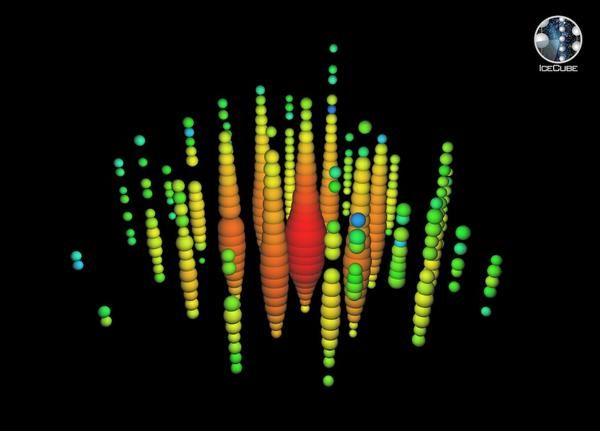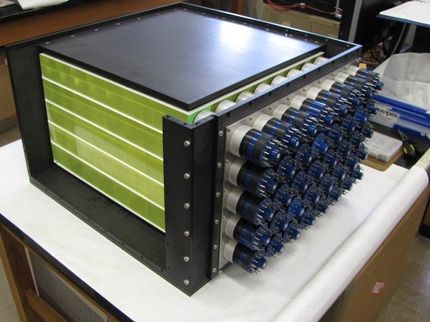IceCube detects first high-energy neutrinos from the cosmos
Advertisement
Within the eternal ice of Antarctica, scientists have observed the first solid evidence for high-energy neutrinos coming from cosmic accelerators beyond our own solar system. Between May 2010 and May 2012 the IceCube detector at the South Pole captured a total of 28 neutrinos with energies greater than 30 teraelectronvolts (TeV). Two of the neutrinos had an energy of more than 1,000 TeV — that’s more than the kinetic energy of a fly in flight — compressed into a single elementary particle. The international IceCube collaboration, in which DESY is the second-largest partner after the University of Wisconsin-Madison, now presents these observations in the current cover story of the scientific journal Science.

This is the highest energy neutrino ever observed, with an estimated energy of 1.14 PeV. It was detected by the IceCube Neutrino Observatory at the South Pole on January 3, 2012. IceCube physicists named it Ernie.
The IceCube Collaboration
“This is the first indication of very high-energy neutrinos coming from outside our solar system,” says Francis Halzen, principal investigator of IceCube and the Hilldale and Gregory Breit Distinguished Professor of Physics at the University of Wisconsin-Madison. Neutrinos are elementary particles that have almost no mass and interact extremely seldom with other particles. They are unique messengers of the highest-energy events in the universe, because in contrast to light they can easily escape from extremely dense environments — such as the core of a supernova explosion or the interior of cosmic particle accelerators.
For example, neutrinos from the famous supernova 1987A reached the Earth approximately three hours before the flash of light, which first had to make its way out of the supernova. “However, the neutrinos that have now been detected by IceCube have energies that are millions of times higher than those coming from supernova 1987A,” emphasizes the head of the neutrino astronomy group at DESY in Zeuthen near Berlin, Dr. Markus Ackermann.
The advantage of the neutrinos as cosmic messengers is also a disadvantage. That’s because they fly through matter so easily that countless neutrinos penetrate the earth every second without leaving any trace. Very seldom does a neutrino collide with another particle. Gigantic detectors are needed in order to enable researchers to occasionally observe such a neutrino event. IceCube, the largest particle detector in the world, encompasses a whole cubic kilometre of the eternal ice of the Antarctic. Inside IceCube, a total of 5,160 sensitive detectors hang from 86 steel cables. These detectors, which are known as optical modules, are sensitive to the weak flashes of light that are generated by a neutrino collision. After a construction period of seven years, the gigantic detector was fully operational at the end of 2010.
The first hints of extra-terrestrial high-energy neutrinos came with the unexpected discovery in April 2012 of two detector events above 1000 TeV. The IceCube scientists nicknamed these two rare events “Ernie” and “Bert”. An analysis of those events was reported in the scientific journal Physical Review Letters. An intensified search, the results of which are presented now, turned up 26 additional events beyond 30 teraelectronvolts, exceeding the results expected for neutrinos produced in the earth’s atmosphere.
“Perhaps, we are currently experiencing the birth of neutrino astronomy,” says Ackermann. The analysis did not find any statistically significant clustering of the 28 events either in time or space - the number of events is too small. “We are now working hard on improving the significance of our observation, and on understanding what this signal means and where it comes from”, says collaboration spokesperson Professor Olga Botner of Uppsala University (Sweden). With an increase in the number of events the scientists hope to identify sources of high energy neutrinos in the cosmos.
The international IceCube team consists of 260 scientists from eleven countries. “The success of IceCube builds on the efforts of hundreds of people around the world,” emphasizes Botner. In Germany, apart from DESY nine universities participate in the collaboration: the Technical University of Aachen, the Humboldt University Berlin, the University of Bochum, the University of Bonn, the Technical University of Dortmund, the University of Erlangen-Nürnberg, the University of Mainz, the Technical University of Munich and the University of Wuppertal. Apart from a quarter of the optical modules, the German participants contributed a significant part of the receiver electronics on the ice surface. The German share of about 20 million Euro was funded by the Federal Ministry of Education and Research, the Helmholtz Association, the German Research Foundation, and by the budgets of the participating universities.



























































